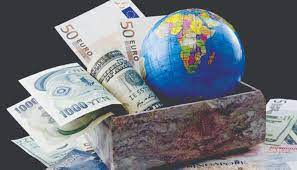Global economic order undergoing a major shift?

Islamabad: The global order is shifting. For better or for worse, the status quo powers (the USA and the West) are weakening and on the other hand the perceived revisionists (China and the East) are encroaching upon the West’s former spheres of influence. What, one may wonder, gives the custodians of the current world order their power? And as such, what is their biggest vulnerability? This single variable, if it goes unchecked, will spill the beans of disaster for Uncle Sam and its allies.
The USA averted yet another threat of default on its sovereign debt. The USA has been the strongest economy in the world since the Second World War. It possessed almost two thirds of the global gold reserves which gave it immense financial strength and consequently legitimized the US Dollar as a Global Reserve Currency.

Yet by 1971, the USA had printed too much paper currency which threatened it with the inability to pay back the Dollars it had printed, in gold, which was the trend before US President Richard Nixon scrapped the Gold Standard. This ushered in an era of Fiat currencies which were pegged to the US Dollar. But the Dollar itself was not backed by any commodity which would act as a collateral. Money was being printed out of thin air. However, the USA made sure to maintain the strength of the dDollar by signing a deal with Saudi Arabia and later with other oil producing countries, convincing them to sell their oil only in US dollars. This was the Petrodollar and it ensured an artificial demand for the US currency. As the famous slogan in economic terms goes: No Dollars, no trade, no energy. This in turn allowed the US financial institutions, especially the US Federal Reserve, to print as many dollars as they wished since every country in the world had a demand for them. This came with its downsides, however.
Being the most indebted country in the world, the USA’s economy is prone to upheavals in international trade and energy supply. The dollar’s legitimacy depends on the demand that it possesses in global trade. If that demand is lowered, or worse, removed, countries holding US dollars as forex reserves would start selling their dollars in exchange for a new reserve currency or precious metals such as gold. The overselling of the dollar will automatically lower its price relative to other currencies, decreasing its value; as well as causing unprecedented inflation for dollar-dependent economies, especially the US economy itself. Even now, ever since the establishment of the Federal Reserve, the USA’s Central Bank, in 1913, the Dollar’s purchasing power has lowered by 96 percent, that is, an item costing 4 cents in 1913 will cost $1 in today’s money.
Therefore, if the offshore US Dollars find their way back into the mainstream US economy, that will cause extreme Dollar saturation and oversupply which has the capacity to crumble the entire US economy. The Petrodollar is the backbone of the US economy as well as its biggest liability and an existential threat to the USA. This explains the US war on Iraq and later on in Libya where the trend of de-dollarization was gaining traction on the state-policy level.
The war in Ukraine manifested the multi-faceted vulnerabilities faced by nation-states. The world that the USA helped create is slowly crumbling apart. International Sanctions, one of the mainstays of the West’s dominance over the world, have backfired. Russia swiftly came under Western sanctions which, including other events, hindered its ability to trade in dollars. Russia’s exports are heavily dependent on fossil fuels with crude petroleum topping the list.
Not only is Russia still able to sell its petroleum products, but it also is exporting it with an additional insult to injury to the West, by selling petroleum in return for the Russian ruble or the Chinese yuan. The case with the Chinese yuan is interesting and is reminiscent of the interwar period when the US had become the largest producer and exporter in the World which gave its currency, the dollar, great confidence. The same confidence is being shown by the yuan as Pakistan has reportedly paid yuan to Russia in return for crude oil. What might come as a surprise is the news circulating about India paying the Russians in yuan as well. Even India, which is considered a pivot for the USA in the Indo-Pacific region, is prepared to ditch the dollar when and wherever suitable.
Therefore, our foremost focus must be on establishing a strong and reliable economy based on industrial production, advancements in the realm of Artificial Intelligence, and prioritizing the national economy in such a way that the result comes in the shape of economic strength.
The USA and its allies are certainly facing an existential crisis. They may not be publicly talking about the decreasing strength of the dollar, yet that does not mean that the threat does not exist.
China is in a highly favourable position to increase its relative power potential vis-à-vis the USA, especially in the larger scheme of the global financial setup. The yuan is backed by the world’s second largest economy and the largest exporter in the world. Due to the demand for Chinese products and the vast networks of trade that China has created for itself, the yuan will always be in demand if China maintains its heavily export-oriented economy. These are all prerequisites for a currency to attain global reserve status and China certainly possesses a leverage in that regard.
Pakistan unfortunately is not able to be decisive about which side to pick. It is true that on the one hand Pakistan has China which has stood by its commitments throughout the good and bad times. It is also a direct neighbour and is the largest foreign investor in Pakistan. It has lent military and economic support to Pakistan and has been its most reliable diplomatic partner as well, especially in the UN.
However, owing to our history of indulgence with the USA, our economy is designed in a subservient model. Since Independence, instead of empowering our own economy through focusing on mass production and exports, we have relied mostly on the US Aid, economic and military assistance, and loans by the International Financial Institutions – which are overtly controlled by the USA. How will our relationship with the IMF, World Bank, and other financial institutions play out? Our military supplies are heavily reliant on Western technologies, especially the USA. If Pakistan does so much as to hint towards a definite shift towards China in the global context, how will we deal with the issue of maintaining those supply chains?
Only economic self-sufficiency and self-reliance will allow us to steer our foreign policy in the direction we want. In this highly interdependent world, paradoxically, it is wiser to be least dependent on others but to have others dependent on you. Pakistan is not in such a position. Exercising an independent foreign policy with a crumbling economy solely surviving on foreign loans and deposits is not even a good fictional plot for the most preposterous of the movies, let alone in the real world that we live in.
However, in the long run, we need to make our decision. The West may be approaching relative weakening and the East will rise spearheaded by China; maybe not swiftly but in the coming 10 to 15 years. In that context, fortunately, Pakistan still has time to gradually align itself more with the states in the region rather than suffering the compulsions thrown at it by the demands of the West which are less than often in line with its own local and regional compulsions.
Therefore, our foremost focus must be on establishing a strong and reliable economy based on industrial production, advancements in the realm of Artificial Intelligence, and prioritizing the national economy in such a way that the result comes in the shape of economic strength.





